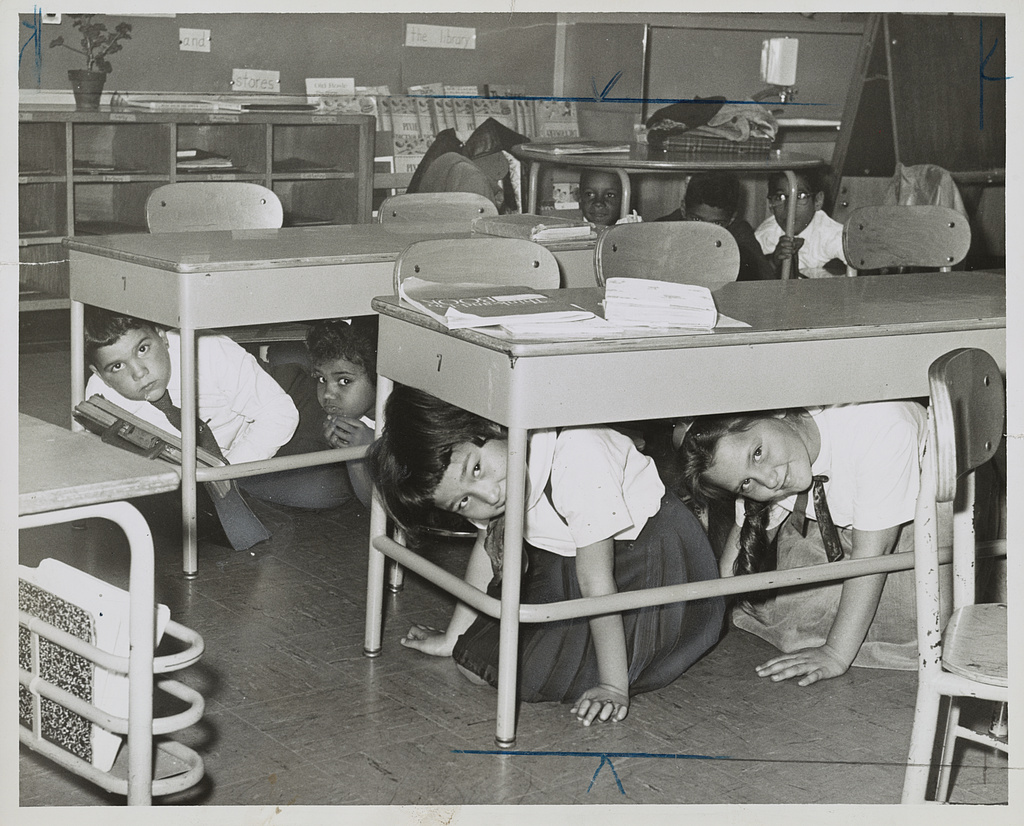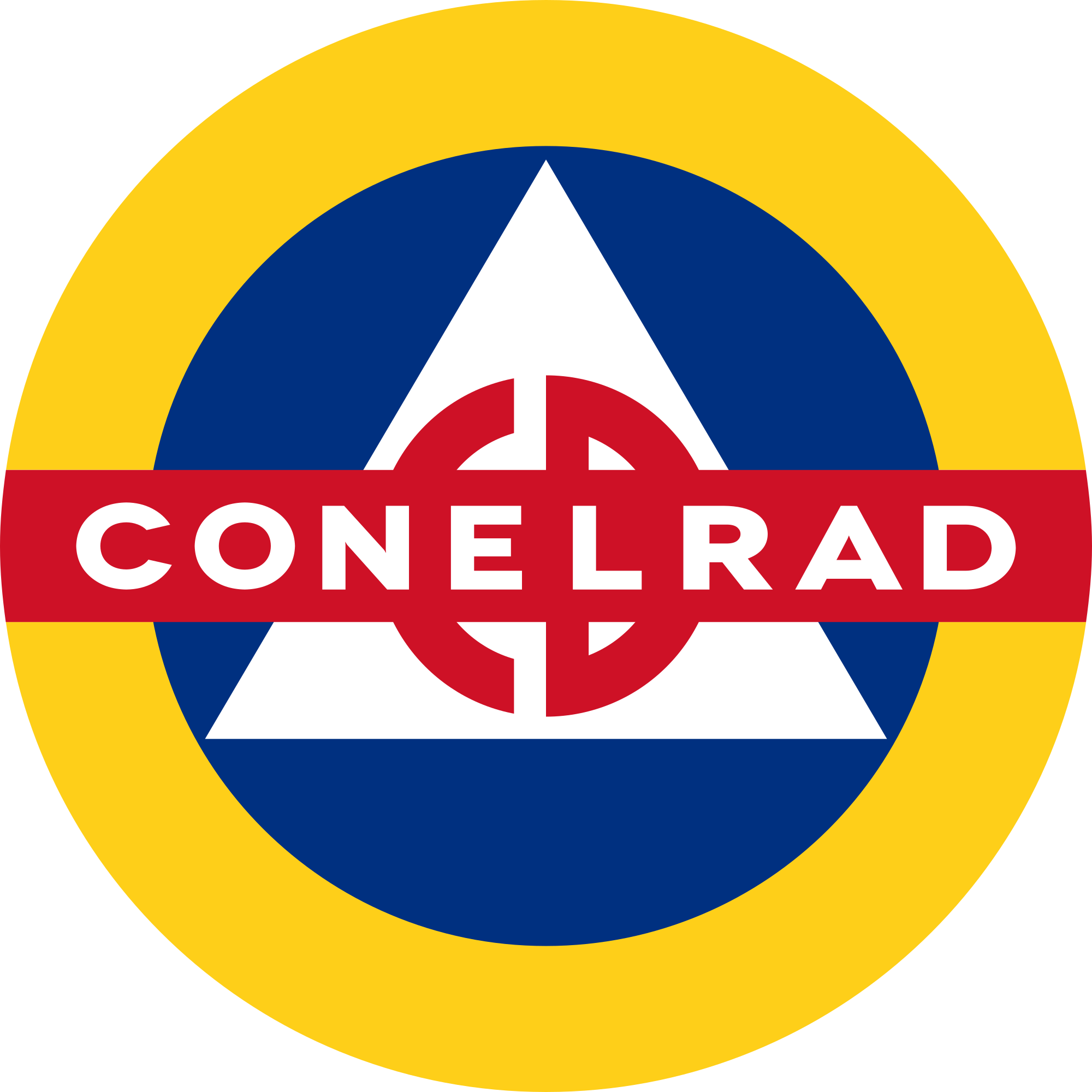On Tuesday, for the inaugural article for this blog, I've outlined a scenario where the USSR never developed an atomic bomb. Part of the reason for that article was this one, which I wrote on the behalf of a local museum for the small town weekly newspaper. That is part of the reason that I started this blog in the first place!
For those to young to remember, the Cold War was a time of mistrustful peace, ideological conflict and the overhanging
fear that at any moment, nuclear Armageddon could be unleashed, resulting in
the destruction of civilization, if not all of humanity, in a blink of an eye.
If you ask those who grew up in the 1950s and 1960s, they can still tell you
about the “Duck and Cover” drills, where they would duck under their school
desks when the sirens went off to warn of air raids. This wasn’t necessarily to
protect you from the fallout, but the burns and falling debris. So, no, school
desks won’t protect you from radioactive fallout!
 |
| Don't worry kids! You'll be fine! |
The period between 1945 and 1991 was
dominated by the political, economic and military conflict between the nations
allied with the United States of America and the Union of Soviet Socialist
Republics, known better as the USSR. The US, Canada, Western Europe (known as
NATO) and dozens of other nations around the world were in favor of capitalism,
while the “Warsaw Pact” of the Soviet Union and the states of Eastern Europe,
China and Cuba pushed Communism as not only a viable alternative, but the future
for the whole world.
At first, only the US had access to nuclear
weapons technology, but by 1949 the USSR had it’s own nuclear weapon, partially
thanks to spies and informants in the American and British Manhattan Project
that passed information to the Soviets, as I mentioned early this week. Fear and paranoia in America about
Soviet spies lead to the “Red Scare,” lead by Senator Joe McCarthy and the
House Un-American Activities Committee, but more directly it lead to panic that
the Soviet Union could now bomb the US. In 1951, President Harry Truman therefore established a new system to warn the American people in the event of
a nuclear war, CONELRAD.
 |
| Pretty creative logo, huh? |
Before 1951, there was no system in the US,
much less Canada, to warn the American people over radios or the new medium of
television. While radio stations did interrupt broadcasting during the attack
on Pearl Harbor in December 1941 and the first successful tornado alert was
sent over the radio in 1948, there was no unified, national system.
CONELRAD was the first such system.
Standing for CONtrol of
Electromagnetic RADiation, it
had a two step goal: to warn the American people, and to throw off the nuclear
armed Soviet Bombers sent to attack American cities. In the event of a nuclear
attack, all TV and FM radio stations would go off the air, and the few stations
left on the air would broadcast at 640 or 1240 kHz for a few minutes then shut
off, then another station would take over for a few minutes before it shut off
and another station would take it’s place. This was designed to confuse Soviet
bombers that might be using radio frequency detection equipment to find
American cities, apparently in the belief that USSR pilots couldn’t find the
big, sprawling cities and military bases that were their targets! In order to
alert stations in the “Key Station System,” an ad-hoc approach of shutting down
and turning on the transmitter of the main stations several times before
sending out an ear piercing shriek actually lead to failures and false warnings
when transmitters, not designed to be rapidly turned on and off, failed to restart.
 |
| Posters like this were a major part of the information campaign issued by the Federal Civil Defense Administration of the US during the early Cold War. |
Between 1953 and 1963, all radios made in
the US had the symbol of Civil Defense (a triangle inside a circle, often with
a CD) marked at 640 and 1240 AM. When the alert was issued, everyone was to
turn to one of these stations to hear pre-recorded instructions and information
from the Board of Civil Defense about how to survive in a nuclear exchange: do
not go outside in fallout, turn off gas, save water and ration your food were
the primary messages. When many of the messages were later de-classified,
scientists discovered that the information about fallout and nuclear blasts provided
in the broadcasts were almost totally wrong, which raises questions about
exactly how many people would have survived following CONELRAD’s instructions.
And as with all technology and human error, we would never know if CONELRAD
would have fully functioned in a nuclear war, or if people would listen to the
messages that were sent, as most asked that parent's not worry to find their kids if they were in school, stay off phone lines for emergency personal only, and, if there was not enough time, not to evacuate and clog up the roads. All of these things would have been counter to instincts would suggest. I'm unsure if CONELRAD, even if it worked flawlessly to alert people, would have saved many lives.
 |
| This is the radio that I found at the museum I was working at this summer that sparked this article |
 |
| Here you can see the "CD" and triangle that marked where to turn the radio to in the event of a nuclear war. |
Thankfully, CONELRAD, nor its successors
have been used to warn the American people of a nuclear war. CONELRAD was shut
down in 1963 after the Cuban Missile Crisis when intercontinental ballistic
missiles (ICBMs) were seen as the bigger threat than Soviet bombers, so trying
to disrupt radio path-finding equipment was not necessary, and the Emergency
Broadcast System (EBS) took it’s place. Today the Emergency Alert System (EAS),
which replaced the EBS in 1997, is used to warn of natural and manmade
disasters besides its original Cold War goal of nuclear war. The EBS especially became a major facet of the culture of the Cold War, being used in movies like The Day After and comedy, and still used today, as the Winnipeg Free Press mocked when the 2015 General Election was called in Canada:
And it was only in
2015 when Canada established it’s own public emergency system, Alert Ready,
which allows Environment Canada and provincial authorities to issue alerts to
public safety quickly, with the goal to save lives in emergency situations. While the first few times it had been activated for tornado warnings, the computerized voice garbled town names, and in some cases came on after the tornado had already touched the ground or had left.
If you want to scare yourself, or rather would like to hear what could have happened, here are two links to simulated or pre-recorded messages that would have occurred in the event CONELRAD or the more modern EAS had been activated:
A prerecorded message by Dick Chapman and Minnesota Governor Elmer Andersen
A simulated CONELRAD activation in the Spring of 1962. Well done voice acting and the Password Game was the one that would have been shown on the date!
A modern revision if the Emergency Alert System is activated in the event of a nuclear war in New York
No comments:
Post a Comment